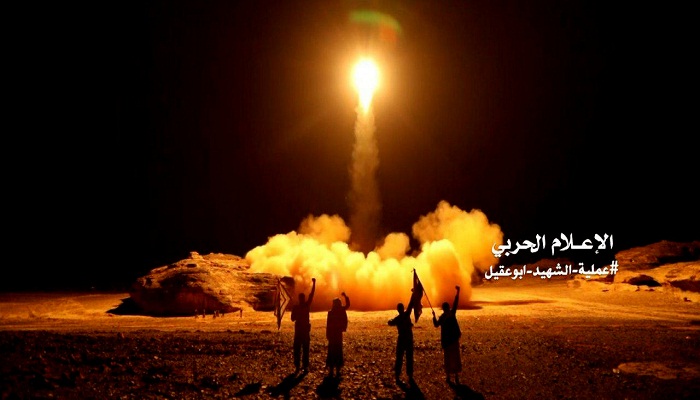A Salvo of Missiles Fired on Foreign and local paid fighters on the West Coast
A.Abdulkareem
report
Yemen army launched a salvo of ballistic missiles against gathering of Saudi-UAE troops and paid fighters on the West Coast, early Tuesday, accuratley. The forces of the coalition and paid fighters suffered heavy losses,Yemeni forces who have been confronting the Saudi-led coalition on the Arab impoverished country inflicted heavy losses on paid fighters hired by the coalition powers in the western coast front
US-Saudi-led Coalition launched a large-scale operation in Hodeida which remains the only lifeline for more than 13 million and the gateway to the majority of its aid-dependent population ,it offers a window into the nation’s dire plight.it caused humanitarian catastrophe.Ten of thousands of civilians have displaced from home in Hodeida ,suffering from serious condition as a result of Saudi camgain
A source military further said the Yemeni army would increase such retaliatory attacks against Saudi bases and facilities in near future. It comes in retaliation to Saudi-led Coalition devastating military operations against the West Coast f.
Yesterday, a ballistic missile, Qaher 2M, was launched on the gathering of the coalition and their paid fighters on the West Coast Front, and on the fifth of this month a missile of the same model was launched on the gatherings of the coalition and paid fighters in the West Coast Front
Abdulmalik al-Houthi, the leader of the Houthi movement, which is the main force that faces the coallition, said on a TV speech on Sunday,” The decision of invading the Yemeni ,western coast, has been taken and adopted by the United States of America,noting that the Saudis are trying to abolish Yemen’s freedom,” stressing that it was the people of Yemen’s right to defend their country.
“The Yemeni army would increase such retaliatory attacks against Saudi bases and facilities in near future,” according to a statement to MintPress by a high-ranking of Yemen Official Military.” Those who bet on the support of foreign forces will never reach satisfied results”

A source in the Yemeni defense ministry said in a statement that Yemeni forces manage to repel the UAE-led offensive, which has lasted for two days, destroying 20 US vehicles and managing to seize arms left by paid fighters,and reiterating threats that the western coast front in Yemen will witness many surprises
On Saturday,Yemen drones bombarded Abha International Airport in the kingdom’s southwestern province of Asir with several airstrikes for the second time in more than a month, inflicting damage upon it, and forcing the authorities to suspend all flights to and from the regional airport
The official spokesman of the Saudi-led coalition attacking Yemen,Colonel Turki Al Malki, said it had foiled an attempted “terrorist” attack by an unmanned drone near Abha airport, describing it as a serious escalation.
On April 11, the Yemeni Qasef-1 remote control drones carried out a similar attack on the airport that led to the temporary cancellation of all its flights to Jizan, Jeddah and the capital Riyadh
Two years ago, the Yemeni Air Force launched its newly created “Toshka” ballistic missile against a Saudi military base in Safer, eastern Yemen, causing a huge blast and inflicting numerous casualties on coalition troops. Fifty-two Emirati, 10 Saudi, and five Bahraini troops as well as dozens of Saudi-backed paid fighters were killed in the attack.
On September 7, 2016, a new ballistic missile dubbed the “Borkan H-1” (or “Volcano H-1”) was unveiled. The Borkan is a modified from Scud, which was used to strike a military base near Riyadh, more than 800 km from Yemen’s northern border. Later, the Yemeni Air Force unveiled the “Borkan H-2”, which was able to evade U.S. Patriot missiles defenses and land near the King Khalid International Airport near Riyadh.
In February 2017, Yemen unveiled four domestically manufactured drones — the Qasef-1 (Striker-1), the Hudhud-1 (Hoopoe-1), the Raqib (Observer), and the Rased (Surveyor) — all of which perform a variety of tasks, including aerial monitoring, battlefield observation, and geophysical surveying

